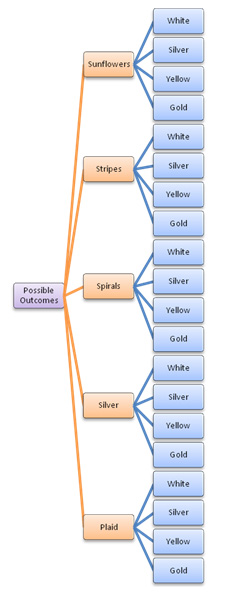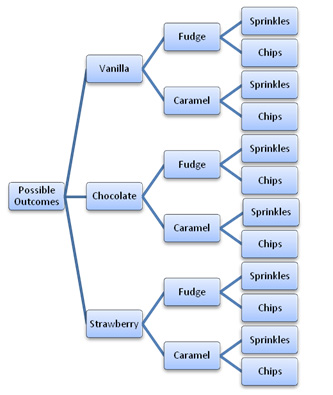By definition, a compound event consists of two or more simple events. Tossing a die is a simple event. Tossing
two dice is a compound event. The probability of a compound event can be calculated if its outcomes are equally
likely.
Review of Simple Probability
The probability of a simple event is a ratio of the number of favorable outcomes for the event to the total number of
possible outcomes of the event.
The probability of an event A can be expressed as:

Examples
-
One Die - 6 possible outcomes
-
One coin - 2 possible outcomes
-
One deck of cards - 52 possible outcomes
-
One fair number cube - 6 possible outcomes
Finding Outcomes of Compound Events
The total outcomes of each event are found by using a tree diagram or by using the fundamental counting
principle.
Example:
A gift-wrapping service offers the following choices.
Paper: Sunflowers, Stripes, Spirals, Silver, Plaid
Ribbon: White, Silver, Yellow, Gold
There are two ways to find the possible outcomes of compound events.
-
Use a tree diagram
Use the fundamental counting principle
Tree Diagram
The sample space for a compound event can also be described using a tree diagram in which the path along the
branches gives the set of all possible outcomes.
Using a tree diagram to determine the number of possible sandwich combinations, we have this diagram:

The Fundamental Counting Principle
The fundamental counting principle states that "If there are r ways to do one thing, and s ways to do another, and t
ways to do a third thing, and so on ..., then the number of ways of doing all those things at once is r x s x t x ..."
Applying the principle, there are 5 choices for paper and s choices for ribbons. Thus, the number of possible
outcomes is 5 x 4 = 20.
Try these questions
-
David and Adrian have a coupon for a pizza with one topping. The choices of toppings are pepperoni,
hamburger, sausage, onions, bell peppers, olives, and anchovies.
If they choose at random, what is the probability that they both choose hamburger as a topping?

-
The Bagel Factory offers 12 different kinds of bagels and 4 types of cream cheese. How many possible
combinations of bagels and cream cheese are there?
-
12
-
16
-
24
-
48
-
A pair of dice is rolled once. How many possible outcomes are there?
-
12
-
24
-
36
-
72
-
A coin is tossed with the 1st, 2nd and 3rd toss resulting to all tails. What is the probability that the 4th toss will
be heads?
-
1/4
-
1/16
-
1/2
-
2/13
-
Two cards are picked from a standard deck of 52 cards. The first card is a king. What is the probability that the
second card picked is also a king?
-
3/13
-
1/17
-
5/23
-
1/51
FINAL TEST QUESTIONS
-
The fundamental counting principle states that if you have A ways of doing the first event, B ways of doing the
second event, and c ways of the third event, then you can find the total number of outcomes by multiplying:
A. B. C. True or false?
Answer: True
-
A survey at a hospital showed the most popular names for baby girls are: Emily, Haley, Kayla, and Samantha.
The most popular middle names for baby girls are Anne, Elizabeth, and Marie. How many possible names can
be generated using the first and middle names from the list of popular names?
-
12
-
7
-
4
-
3
-
An event made of two or more events that can happen either at the same time or one after the other.
-
Dependent event
-
Independent event
-
Compound event
-
Simple event
-
Using the diagram for making an ice cream sundae, how many different kinds of ice cream sundae can one
create?

-
3
-
6
-
9
-
12
-
From the tree diagram of Question 4, how many different kinds of ice cream can one make where fudge as
syrup?
-
3
-
6
-
9
-
12
-
The Burger Shop offers 2 types of burgers, 5 types of beverages, and 2 types of desserts. If a meal consists
of one burger, one beverage and one dessert, how many possible meals can be chosen?
-
20
-
10
-
5
-
2